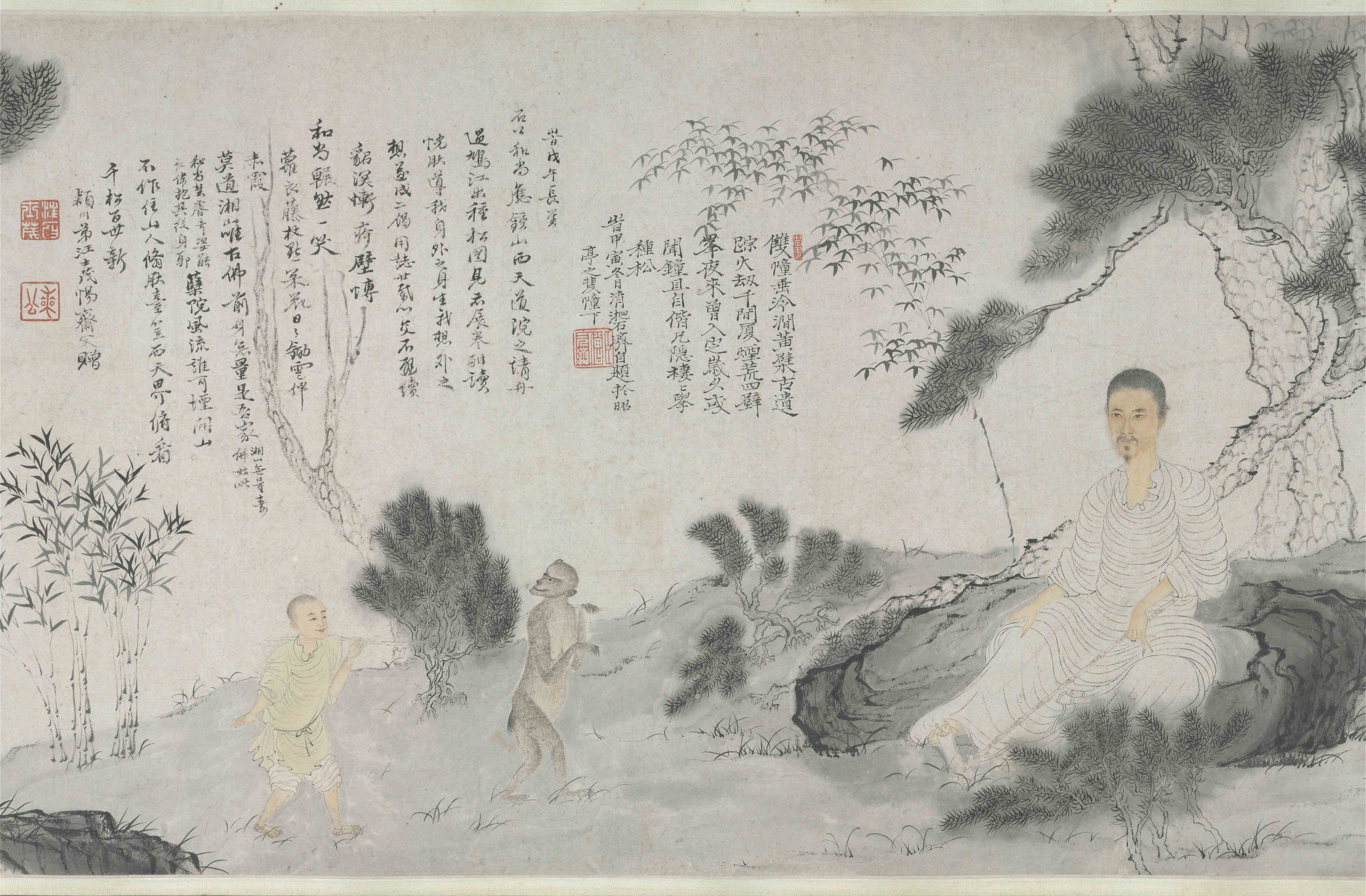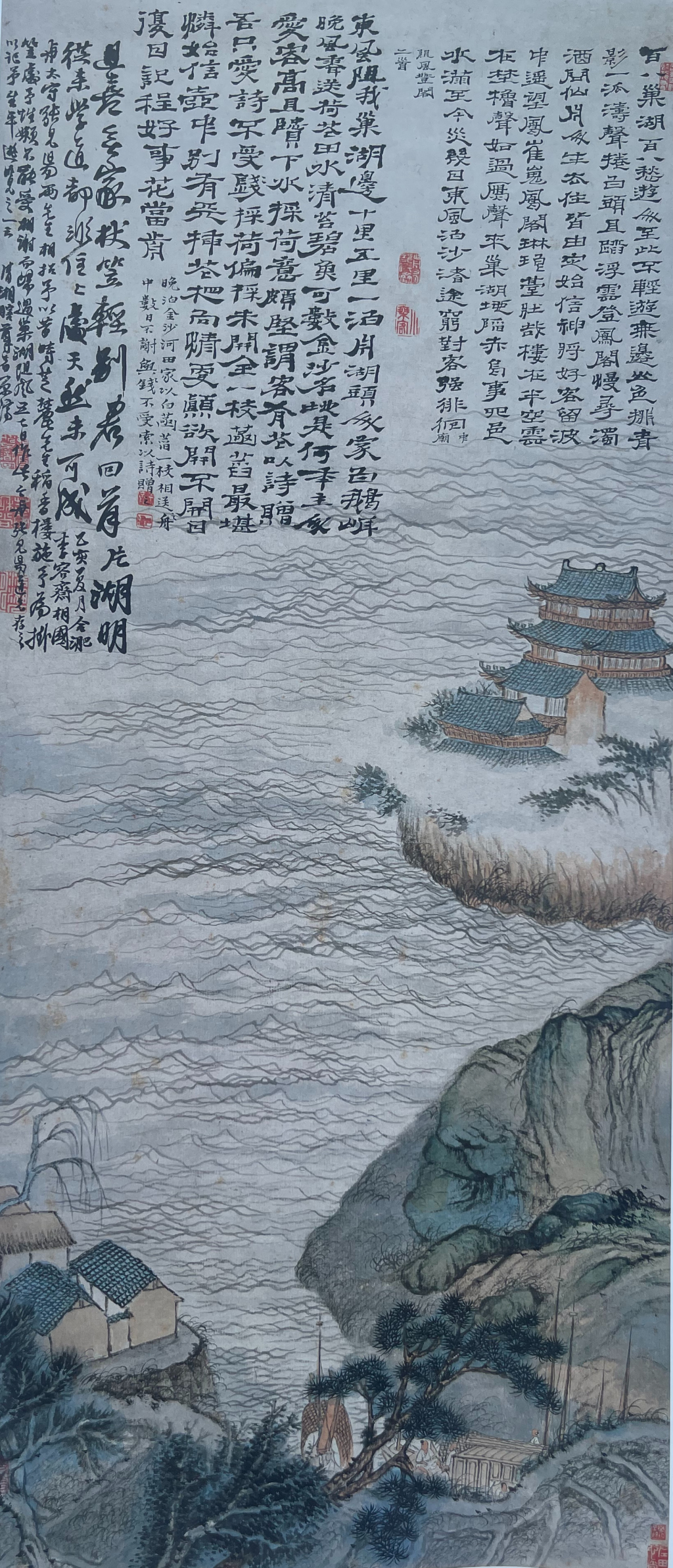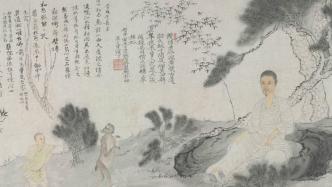
The Paper learned that a new book launch for "Shitao and Yangzhou" was recently held in He Garden in Yangzhou. The book was edited by Peking University professor Zhu Liangzhi and Yangzhou Landscape Architecture Society chairman Xu Liang, and published by Guangling Bookstore. It brings together many scholars' research on Shitao's practical creations in painting, calligraphy, stone stacking and other aspects.
As a great painter in the late Ming and early Qing dynasties and one of the "Four Monks of the Early Qing Dynasty", Shitao (1642-1707) had a huge influence on the history of Chinese painting and calligraphy and aesthetics. In addition to his achievements in painting and calligraphy, he was also a garden builder. Shitao lived in Yangzhou in his later years, and most of his important paintings and calligraphy works in his mature period were created in Yangzhou. He also left behind some remains of garden stone stacking in Yangzhou.

Shi Tao's "Self-portrait of Planting Pine Trees" is collected by the National Palace Museum, Taipei

Book cover of Shi Tao and Yangzhou, published by Guangling Publishing House
"The fertile land of Yangzhou has a very important influence on Shitao's artistic creation. In Yangzhou, Shitao's calligraphy and painting art reached a more rounded and mature state. Especially here, his multiple talents were fully displayed, he wrote poems, painted, wrote books, made seals, and even stacked stones to build a garden." At the new book launch, Zhu Liangzhi said that Yangzhou's natural scenery, cultural atmosphere and historical accumulation became the soil and source of inspiration for Shitao's artistic expression, making him a Shitao who was both unparalleled and full of sad and lingering thoughts.

The launch of the new book "Shi Tao and Yangzhou"

Professor Zhu Liangzhi, Professor of Peking University, Director of the Center for Aesthetics and Aesthetic Education, and Editor-in-Chief of Shi Tao and Yangzhou, made a speech
Wang Qinghai, member of the Party Working Committee and deputy director of the Management Committee of Yangzhou Shugang-Slender West Lake Scenic Area, said: "The book "Shitao and Yangzhou" is based on Shitao culture, explores the deep roots with Yangzhou, and deeply explores his artistic essence and creative charm. The scenic area will take this new book launch as an opportunity to strengthen cooperation and exchanges with famous artists, continuously enhance the popularity and influence of Shitao culture and Yangzhou garden culture, and help Yangzhou build an internationally renowned cultural tourism destination.
Xu Liang, chairman of the Yangzhou Landscape Architecture Society and one of the editors-in-chief of "Shitao and Yangzhou", introduced the origin of the book: "Since 2018, the idea of publishing this book has been born. During the long wait and careful preparation, the original intention has never changed. Finally, after six years of hard work, it came out. This book embodies the respect of many scholars for Shitao and their deep affection for Yangzhou culture. Whether it is Professor Zhu Liangzhi's decades of research on Shitao, or the special feelings of scholars such as Liu Mo and Zhu Tianshu for Yangzhou, all make this book full of warmth. This feeling has also continued in the protection and dissemination of Yangzhou garden culture."

In June 2024, scholars attending the Shi Tao and Yangzhou Symposium visited Pianshi Shanfang
In his creation and theory, Shitao proposed "searching for all the strange peaks to make drafts", "one painting theory", "brush and ink should follow the times", etc., which had a huge influence. His famous stone stacking work "Pianshi Mountain House" remains in the He Garden in Yangzhou today, which has had a profound impact on stone stacking and mountain building in later generations.

Shi Tao Memorial Hall in He Garden, Yangzhou, Shi Tao sculpture
Many years ago, the He Garden in Yangzhou established the Shitao Memorial Hall next to the Pianshi Mountain House to present the relationship between Shitao and Yangzhou. The Shitao sculpture created by sculptor Wu Weishan is also placed in the Shitao Memorial Hall in He Garden.

Shi Tao paintings
Regarding Shi Tao's stone stacking, Li Dou of the Qing Dynasty wrote in "Yangzhou Huafanglu": "Shi Yuanji, whose name is Shi Tao and whose nickname is Dadizi... is good at painting landscapes and flowers, and he paints them freely, with clouds bursting out. He is also good at stacking stones. Yangzhou is famous for its gardens, and famous gardens are famous for their stacked stones. Yu's Wanshi Garden was created by Yuanji, and it is still a famous site today."
Mr. Chen Congzhou, a garden scholar of his generation, published "Yangzhou Pianshi Shanfang - Shitao's Rockery Works" in 1962, pointing out that "(Shitao) was also proficient in garden rockery. Books such as "Yangzhou Huafanglu", "Yangzhou Fuzhi" and "Lüyuan Conghua" all mentioned that he was also good at stacking stones, and he also left behind a number of rockery works when he lived in Yangzhou." After the publication of this article, it had a great influence and became the mainstream voice in the garden academic community.

It is said that the remains of Shi Tao's garden still exist in the ancient city of Yangzhou
Zhu Liangzhi introduced that Shitao's friends left a lot of documents about his garden construction. Bada Shanren's inscription "Why do you, a deserted man, untie your belt and turn the stones?" involves Shitao's stacking of stones. Turning stones means piling stones. Another example is "Shitao set up a large stone green in Guangling", "setting stones" means stacking stones. Shitao's friend Du Cheng wrote a long postscript on his painting "Small Scene of Bitter Melon", which includes the sentence "When the stones come, they are like high mountains, and the officials are shocked by Jing Guan." This postscript provides an important material for this. ... Shitao's "rolling stones" - stacking stones and arranging water in the garden shocked the officials, who thought it could even take away the momentum of Jing Hao and Guan Tong's landscapes.
"It is undeniable that Shitao was a master of stone stacking during the Kangxi period," said Zhu Liangzhi.

He Garden in Yangzhou, a stone house in the rain
Yangzhou's canal culture had a huge impact on Shitao. Yangzhou, where Shitao lived in his later years, was a distribution center for salt for officials and civilians in six provinces, including Jiangsu, Anhui, Jiangxi, Hunan, Hubei, and Henan. Merchants from various provinces gathered in Yangzhou, and Yangzhou's business was increasingly prosperous. It had recovered from the war. Shitao had a deep connection with Yangzhou. Before settling in Yangzhou, he had been there at least four times. In his later years, Shitao settled in Yangzhou and began to build a "home" for himself. "Dadi Thatched Cottage" was Shitao's final destination. Because of his residence "Dadi Thatched Cottage", Shitao also gave himself the nickname "Dadizi" in the last few years of his life. Shitao's works created in his later years can often be found to be made in "Dashutang", "Under the Big Tree", "Under the River" and other places. Most of his representative paintings were completed in Dadi Thatched Cottage, and were often signed with names such as "Qinglian Caoge", "Gengxin Caotang", and "Daizhan Caotang".

Map of Yangzhou Prefecture during the reign of Emperor Kangxi in the Qing Dynasty
In addition, Shitao had a wide range of friends in Yangzhou, including Huizhou merchants such as Jiang Shidong, Min Xiangnan, and Cheng Daoguang, and scholars and poets such as Li, Tao Ji, Tao Wei, Zhu Guan, and Huang Yun. These people not only influenced his artistic path, but also influenced his activities in his later years. Shitao also had another type of friends in Yangzhou. They were either the remnants of the previous dynasty, or poets, or upright people who wandered around the world. In short, they were a group of scholars active in this flashy world and wanderers in the dense scholar community of Yangzhou. Among them were Weiyang chivalrous poet Zhuo Ziren, romantic talent Fang Pu Shi, wild guest Huang Yibu, Shangyuan old man Du Shuzai, Jiangshang mad guest Xiao Zhengyi, and so on. Shitao's eccentric temperament and unsociable personality made him communicate with these eccentric scholars, and he enjoyed each other and pushed each other to achieve the high spirits and enjoy the inner freedom. In Yangzhou, a place of romance, flowers, snow and moon, Shitao stubbornly maintained the purity of his soul. Not only in painting and stacking stones, Shitao's calligraphy creation also had a great influence on later generations. Shitao's calligraphy and poetry and painting are integrated. His creation concept of poetry, calligraphy and painting has a profound influence on the later "Eight Eccentrics of Yangzhou" Jin Nong and Zheng Banqiao, who inherited and developed it. Zheng Banqiao's "Six and a Half Points Calligraphy" is a mixture of seal script, official script, running script and regular script, with varying sizes. This variation technique originated from Shitao. Jin Nong wrote "Huashan Stele", which is actually in the same vein as Shitao's official script.

Exhibition site of Shi Tao Memorial Hall in He Garden, Yangzhou

A detail of Dadi Thatched Cottage in Shi Tao's landscape fan painting "Enjoying Autumn in the Mountain" (collected by Shanghai Museum). The postscript to this painting reads: "Yu Ruo Weng came from Qinhuai to visit me under Dadi Cottage...I asked him to write a few strokes. The old man in the courtyard seemed to have a sad autumn mood in his heart."
According to reports, the book "Shitao and Yangzhou" includes all the articles from the academic seminar "Shitao and Yangzhou", including Zhu Liangzhi's "Shitao as a Master of Stone Stacking", Xu Liang's "'Fairy Tale and Historical Facts' - A Study of Shitao's Stone Stacking in Yangzhou Gardens", Zhu Yuhui et al.'s "From Hengfeng to 'Hengzhou' - Shitao's 'One Painting' Method in a Three-Dimensional Context", Liu Mo's "Notes on Shitao and Yangzhou", Lv Xiao's "A Study of Shitao's 'Jinling Reminiscences' during the Yangzhou Period", Gu Cunyan's "The Canal Water in Shitao's Pens - Starting from 'Huaiyang Jieqiu Tu'", Tan Shengguang's "Shitao's Early Deeds and Artistic Creations", and Zhu Tianshu's "Notes on Shitao's Calligraphy in the Palace Museum".
The publication of "Shitao and Yangzhou" will also allow more people to have a deeper understanding of the profound roots of Shitao and Yangzhou, as well as the special connection between Shitao and He Garden, in the form of an academic dialogue that transcends time and space.


